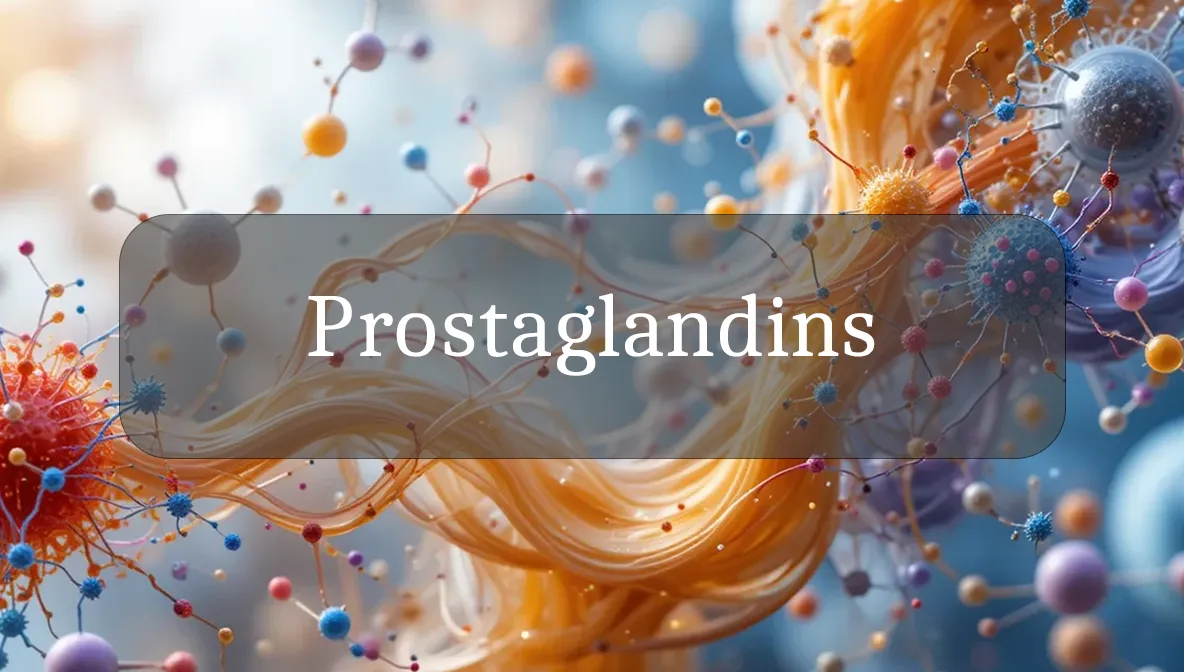Body’s Messengers for Healing and Balance
Prostaglandins are like your body’s tiny firefighters, rushing to manage inflammation, pain, and healing while keeping systems like blood flow and digestion in check. These lipid-based molecules are key players in daily wellness, helping your body respond to challenges and recover effectively. Let’s explore what prostaglandins are, how they benefit your health, and practical ways to support their balance—all in a clear, friendly way to empower your wellness journey.
Chemical Identity and Type
Prostaglandins are lipid-based molecules belonging to the eicosanoid family, derived from arachidonic acid, a fatty acid found in cell membranes. They’re produced on demand by nearly every cell in your body, especially during injury or stress, through enzymes like cyclooxygenase (COX). Acting as body signals, prostaglandins bind to specific receptors to regulate inflammation, pain, and other processes. They’re not stored but made as needed, making their balance dependent on diet and lifestyle.
Biological Role and Benefits
Prostaglandins are your body’s multitasking responders, managing critical processes for health. Here’s how they support your wellness:
- Inflammation Control: They trigger inflammation to fight infections or heal injuries, then help calm it to prevent chronic issues.
- Pain Regulation: Prostaglandins signal pain to alert your body to injury, aiding recovery while keeping you aware of limits.
- Blood Flow Support: They relax or constrict blood vessels, helping regulate blood pressure and improve circulation.
- Digestive Health: Prostaglandins protect the stomach lining and promote gut motility for smooth digestion.
- Reproductive Health: They support uterine contractions during menstruation or childbirth and aid fertility processes.
By balancing these functions, prostaglandins boost your recovery, comfort, and overall vitality.
Dietary or Natural Sources
Your body makes prostaglandins from arachidonic acid, found in omega-6 fatty acids in your diet. Key sources include:
- Animal-Based: Eggs, beef, chicken, and fish (rich in arachidonic acid).
- Dairy: Milk, yogurt, and cheese.
- Plant-Based: Soybeans, peanuts, and vegetable oils (e.g., corn, sunflower).
- Nutrient Boosters: Omega-3 fatty acids (salmon, flaxseeds), vitamin C (oranges, bell peppers), zinc (nuts, beans), and antioxidants (berries, turmeric) help balance prostaglandin production by reducing excessive inflammation.
- Anti-Inflammatory Foods: Ginger, garlic, and green tea may calm overactive prostaglandin effects.
No prostaglandin supplements exist, as they’re made in the body. Omega-3 supplements (1–2 grams daily) or antioxidant supplements (e.g., vitamin C, 500–1,000 mg daily) can help regulate prostaglandin activity. Aim for a balanced omega-6 to omega-3 ratio (4:1 or lower) to avoid excess inflammation.
Signs of Imbalance or Dysfunction
Prostaglandin imbalance, often from overproduction or underproduction, can lead to health issues. Signs include:
- Excess Prostaglandins:
- Chronic pain or inflammation (e.g., joint pain, swelling in arthritis).
- Menstrual cramps or heavy periods.
- Headaches or migraines.
- Digestive issues like stomach pain or ulcers.
- Low Prostaglandins:
- Slow healing from injuries or infections.
- Poor digestion or stomach lining issues (e.g., increased ulcer risk).
- Weak immune responses to pathogens.
Overproduction may stem from high omega-6 intake, stress, or conditions like arthritis or endometriosis. Underproduction is rare but can occur with poor fat intake or enzyme deficiencies.
Supporting Optimal Levels or Function
To keep prostaglandins balanced and maintain their benefits, try these practical steps:
- Eat Balanced Fats: Include omega-3-rich foods (salmon, chia seeds) and limit omega-6-heavy oils (corn, soy) to moderate prostaglandin production.
- Boost Anti-Inflammatory Nutrients: Eat vitamin C (berries, peppers), zinc (oysters, seeds), and antioxidants (turmeric, blueberries) to reduce excess inflammation.
- Stay Active: Moderate exercise like walking or yoga (3–5 times weekly) supports healthy inflammation and circulation.
- Get Enough Sleep: Aim for 7–9 hours to regulate immune responses and reduce stress-driven prostaglandin activity.
- Manage Stress: Chronic stress boosts prostaglandin production; try meditation, deep breathing, or mindfulness.
- Stay Hydrated: Drink 8–10 cups of water daily to support digestion and overall health.
- Consider Supplements: Omega-3s (1–2 grams daily) or curcumin (500 mg daily) may help balance prostaglandin effects.
Safety, Interactions, and Precautions
Prostaglandins are naturally produced and safe when balanced, but consider these points:
- Chronic Inflammation: Conditions like arthritis, asthma, or endometriosis involve overactive prostaglandins and require medical management.
- Medications: Nonsteroidal anti-inflammatory drugs (NSAIDs) like ibuprofen block prostaglandin production; overuse may cause stomach issues or reduce protective effects.
- Supplements: Omega-3s or antioxidants are safe but may cause mild digestive upset in high doses (e.g., above 3 grams for omega-3s).
- Allergies: Fish-based omega-3 supplements may trigger reactions in sensitive individuals.
- Medical Conditions: Diseases with inflammation (e.g., Crohn’s) or bleeding risks may need tailored prostaglandin management.
Prioritize a balanced diet and lifestyle to naturally regulate prostaglandin activity.
Fun Fact
Did you know prostaglandins were named after the prostate gland, where they were first discovered in semen? Don’t worry—they’re made all over your body and keep way more than just reproduction in check!
Citations
- National Institutes of Health. (2023). Eicosanoids and inflammation. MedlinePlus.
- Mayo Clinic. (2024). Nutrition for inflammation and pain management.
- Cleveland Clinic. (2022). The role of prostaglandins in health and disease.
- World Health Organization. (2020). Nutrient requirements for immune health.
- National Institute of Arthritis and Musculoskeletal and Skin Diseases. (2023). Prostaglandins and inflammatory disorders.

